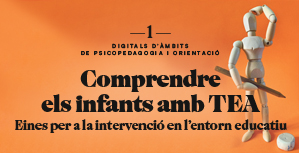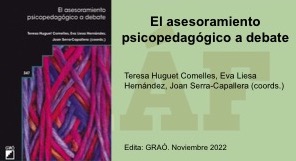La tríada de la inclusión
Resumen
Este artículo describe la introducción de un programa de inclusión para niños y niñas con autismo en una escuela ordinaria a la ciudad de Londres mediante un aula especializada de recursos denominada The Windmill. Basado en la Triad of Impairments o tríada de las dificultades desarrollada por Lorna Wing hace más de 30 años: Comunicación, Interacción Social e Imaginación; el autor nos explica en primera persona la proyección positiva de esta tríada en tres componentes esenciales para el buen éxito del proyecto: el trabajo especializado con los alumnos, el apoyo a los familiares y la colaboración entre profesionales. Este nuevo modelo triangular lo denomina “La Tríada de la Inclusión”. Siguiendo este esquema se describen las herramientas de intervención utilizadas en el centro piloto y se dan pistas para la posible creación de un centro de apoyo con las mismas características.
Citas
Bondy, A.S. and Frost, L.A. (1994). The Picture Exchange Communication System. Focus on Autistic Behaviour, 9; (3), pp. 1- 19.
Boyd, B.A. (2002). Examining the relationship between stress and lack of social support in mothers of children with autism. Autism, 17; (4), pp. 208-215.
Carpenter, B., Ashdown, R. and Bovair, K. (Eds.) (2001). Enabling Access. Effective teaching and learning for pupils with learning difficulties, London: David Fulton.
Charman, T., Pellicano, L., Peacey, L.V., Peacey, N., Forward, K. and Dockrell, J. (2011). What is Good Practice in Autism Education?, London: AET.
Cox, A.J. (2006). Boys of few words: Raising our sons to communicate and connect, Guilford Press.
del Rio, M. J. (Ed.) (1997) Lenguaje y comunicación en personas con necesidades especiales, Barcelona, Martínez-Roca.
Gallego Ruiz & Gallego Ortega (1995) Manual de logopedia escolar, Málaga, Ediciones Aljibe.
Gray, C. and Garand, J. D. (1993). Social stories: Improving responses of students with autism with accurate social information. Focus on Autistic Behaviour, 8; (1), pp. 1-10.
Irish Primary Principals’ Network (2008). Autism provision setting up new units, Glounthaune Co Cork: IPPN.
Janice, E. and Janzen, M.A. (1999). Autism, facts and strategies for parents. Therapy Skill Builders, 100, pp 92.
Jones, G. (2002). Educational provision for children with autism and Asperger syndrome: meeting their needs, London: David Fulton.
Jones, G., Meldrum, E. and Newson, E. (1993). A descriptive and comparative study of interventions for children with autism: Summary report. Birmingham: University of Birmingham.
Jones, G., English A., Guldberg K., Jordan, R., Richardson, P. and Waltz, M. (2008). Educational provision for children and young people on the autism spectrum living in England: A review of current practice, issues and challenges, London: Autism Education Trust.
Jordan, R. (2011). Social and emotional understanding, unit 2, Special Educational Needs of Children with Autism module, DE course Children with Autism, School of Education, The University of Birmingham.
Jordan, R. (2008). Autism spectrum disorders: a challenge and a model for inclusion in education. British Journal of Special Education, 35; (1), pp. 11-15.
Jordan, R. (2001). Autism with severe learning difficulties, London: Souvenir Press.
Lambe, J. and Bones, R. (2006). Student teachers’ attitudes to inclusion: implications for Initial Teacher Education in Northern Ireland. International Journal of Inclusive Education, 10; (6), pp. 511-527.
Matson, J.L., Matson, M.L. and Rivet, T.T. (2007). Social-skills treatments for children with autism spectrum disorders: An overview. Behaviour Modification, 31; (5), pp. 682-707.
Mesibov, G., Schopler, E. and Shea, V. (2004). The TEACCH Approach to Autism Spectrum Disorders, New York: Springer.
Rafferty, Y. (2001). Benefits and risks of reverse inclusion for preschoolers with and without disabilities: Parents’ perspectives. Journal of Early Intervention, 24; (4), pp. 266-286.
Schopler, E. and Mesibov, G. (1983). Social behaviour in autism, London: Plenum.
Simoni, E. (2010). http://EzineArticles.com/4970120 (Accessed 15 November 2011).
Smith, C.M., Rogers, S.J. and Dawson, G. (2008). The Early Start Denver Model: A comprehensive early intervention approach for toddlers with autism, in J.S. Handleman and S.L. Harris (Eds). Preschool Education Programs for Children with Autism.
Walker, M. (1973). An experimental evaluation of the success of a system of communication for the deaf mentally handicapped. (Unpublished MSc thesis available for reference from author or from following libraries: RNID, Gower Street, London; The Hilliard Collection, John Ryland's Library Manchester University),
Whitaker, P. Barratt, P., Helen, J., Potter, M. and Thomas, G. (1998). Children with autism and peer group support: "Using circles of friends". British Journal of Special Education, 25 ; (2), pp. 60-64.
Wing, L. (1995). Autistic Spectrum Disorders: an aid to diagnosis, London: The National Autistic Society.
Wing, L. and Gould, J. (1979). Severe impairments of social interaction and associated abnormalities in children: Epidemiology and classification. Journal of Autism and Developmental Disorders, 9, pp. 11-29.
Descargas
Publicado
Número
Sección
Licencia
Los autores/as conservan los derechos de autor y conceden a la revista el derecho de primera publicación de la obra, registrada bajo una licencia Creative Commons Reconeixement-NoComercial-Sense Obra Derivada. Esta licencia permite la descarga de las obras y que se puedan compartir con otros siempre que se reconozca la autoría, pero no permite que se modifiquen de ninguna forma ni ser utilizadas con finalidad comercial.















